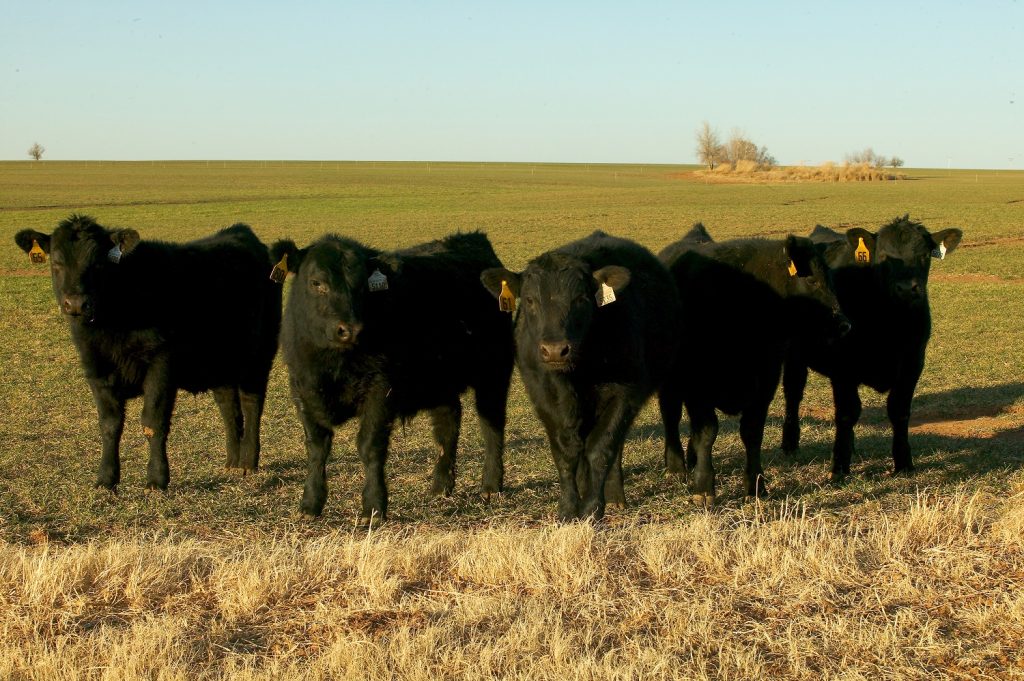
Weekly, Oklahoma State University Extension Beef Cattle Nutrition Specialist Paul Beck offers his expertise on the beef cattle industry. This is part of the weekly series known as the “Cow Calf Corner,” published electronically by Dr. Derrell Peel, Mark Johnson, and Beck. Today, Beck talks about pre-finishing nutrition’s impact on beef quality.
Forage-based finishing systems are gaining attention among cattle producers and consumers. Forage finishing plays to the natural grazing behaviors of cattle and appeals to many consumers. There are many excellent reasons to consider finish calves on forage, however, this system presents two major challenges: land requirement and variable calf performance. A summary of research trials between 1978 and 2013 revealed that cattle finished on forage gain less per day, are typically slaughtered at a lighter weight, have a lower dressing percentage, and have less subcutaneous fat and marbling. The leaner carcass results in beef that is generally rated as less tender, juicy, and flavorful by sensory panels. Despite this, health-conscious consumers may prefer forage-finished beef for its leanness and potential for heart-healthy fat content. Others may still prefer grain-finished beef, especially when sourced locally.
Calf growth rates in forage-finishing systems vary widely. Gains can range from over 2.0 lbs/day in spring and summer to under 0.5 lbs/day during less favorable conditions. It can take over a year for a weaned calf to be market-ready, especially if daily gains are low. Low-quality pastures like toxic tall fescue or bermudagrass limit performance, resulting in long finishing times and leaner carcasses unless supplemental nutrients from higher quality forages or concentrate feeds are provided. Research shows that forages like alfalfa and chicory supported higher average daily gains and better carcass fat deposition compared to grass pastures like bermudagrass or summer annuals such as pearl millet.
Hybrid systems have been studied as an alternative to high-concentrate total mixed rations fed in confinement. These systems utilize the roughage supplied by pasture along with additional energy from supplemental concentrates. They may not meet the requirements to meet ‘grass-fed beef’ claims by the USDA, but they do provide free-choice access to pasture.
Comparisons were conducted where calves from the same ranch were finished at either a commercial feedlot in the High Plains or in the Southeast on bermudagrass pastures. In the first trial, calves from spring or fall calving herds were either sent to a Texas Panhandle feedyard for finishing as yearlings following a stocker program at the home operation or supplemented with 1% of bodyweight per head per day with a grain/grain byproduct supplement consisting of corn and soybean hulls until slaughter. Steers finished conventionally in confinement gained 4.4 lbs/day while steers fed concentrate supplement on pasture gained 2.5 lbs/day. Although the finishing period on pasture was 30 days longer, steers finished in the conventional feedlot were 128 pounds heavier at slaughter, and dressing percentage was higher 62.5% vs 60.6% for Conventional vs pasture finishing. Conventionally finished cattle were 86% Choice while pasture-finished calves were 22% Choice quality grade. In the next trial, 60 calves were either finished in a conventional Texas Panhandle feedyard or were kept on pasture with a grain/grain byproduct concentrate supplement fed at 1.5% of body weight daily. Steers finished on pasture with supplement gained 3.6 lbs per day (vs 4 lbs/day for conventional) and were fed 40 days longer than conventional steers but were still 40 pounds lighter at slaughter. Hot carcass weights, backfat thickness, and dressing percent were slightly lower for pasture-finished calves. Cattle finished on pasture were 100% Choice, while the Conventional steers were 93% Choice.
Ultimately, while forage-finishing systems can align with niche markets and consumer values, they require careful forage management, extended timeframes, and realistic expectations around carcass quality and palatability.
References:
Beck, P.A., Beck, M.R., and Apple, J.K., 2024. Production systems and nutrition. In: Encyclopedia of Meat Sciences III, vol. 1. https://dx.doi.org/10.1016/B978-0-323-85125-1.00029-6. ISBN: 9780323851251
Beck, P., and Lalman, D.. 2021. Finishing Beef Cattle on Farm. Oklahoma State University Cooperative Extension Service. Stillwater OK. AFS-3303

















